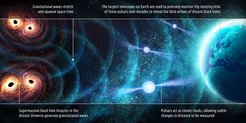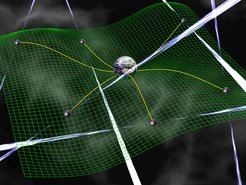A new view of the Universe
Clock-like precision of pulsars opens a new window in the gravitational wave spectrum
An international collaboration of European astronomers including scientists from the Max Planck Institutes for Radio Astronomy (MPIfR) and Gravitational Physics (Albert Einstein Institute, AEI), together with Indian and Japanese colleagues, have published the results of more than 25 years of observations from six of the World's most sensitive radio telescopes. Along with other international collaborations, the European and Indian Pulsar Timing Arrays have independently found evidence for ultra-low-frequency gravitational waves, expected to come from pairs of supermassive black holes found in the centres of merging galaxies. These results are a crucial milestone in opening a new, astrophysically rich window in the gravitational wave spectrum.

In a series of papers published this week in “Astronomy and Astrophysics”, scientists of the “European Pulsar Timing Array” (EPTA), in collaboration with Indian and Japanese colleagues of the “Indian Pulsar Timing Array” (InPTA), report on results from data collected over 25 years, which bring with them the promise of unprecedented discoveries in the study of the formation and evolution of our Universe and the galaxies that populate it.
The EPTA is a collaboration of scientists from more than ten institutions across Europe, and brings together astronomers and theoretical physicists in order to use observations of ultra-regular pulses from extinguished stars called ‘pulsars’ to construct a Galaxy-sized gravitational wave detector.
“Pulsars are excellent natural clocks. We use the incredible regularity of their signals to search for minute changes in their ticking to detect the subtle stretching and squeezing of space-time by gravitational waves originating from the distant Universe”, explains Dr David Champion, senior scientist at the MPIfR in Bonn, Germany.
This gigantic gravitational wave detector - spanning from the Earth to 25 chosen pulsars across the Galaxy - makes it possible to probe gravitational waves frequencies much lower than those probed by other experiments, opening a new window in the gravitational wave universe.
“At the centre of galaxies lurk supermassive black holes, several million times heavier than the Sun. As the pulses from the pulsars travel to Earth they are imprinted with the faint, distant echoes of the gravitational waves emitted by these monster black holes”, says Dr Aditya Parthasarathy, a researcher at the MPIfR. These echos contain information about the cosmic population of supermassive binary black holes which form when galaxies merge, marking the opening of a new window into the Universe.
These results are based on decades of coordinated observing campaigns using the five largest radio telescopes in Europe: the 100-m Effelsberg Radio in Germany, the Lovell Telescope in the United Kingdom, the Nançay Radio Telescope in France, the Sardinia Radio Telescope in Italy and the Westerbork Radio Synthesis Telescope in the Netherlands.
Prof Michael Kramer, director at the MPIfR in Bonn, Germany, emphasises, “Data from the Effelsberg telescope stretches back more than 25 years. This is important, as it makes the EPTA uniquely sensitive to the lowest frequencies probed”.
“Once a month,” adds Dr. Kuo Liu from the MPIfR in Bonn, “the European telescopes are additionally recording data together as the Large European Array for Pulsars (LEAP) to give an extra boost of sensitivity, comparable to the largest radio telescope on Earth”. These observations have been also complemented by data provided by InPTA, leading to the development of a uniquely sensitive dataset.
Dr. Yajun Gou, researcher at the MPIfR, explains the significance, “Our telescopes have observed the pulsars very often and over a very long time. We can probe frequencies of the gravitational waves as slow as 1 oscillation every 30 years, improving the sensitivity towards black hole binary systems with orbital periods up to 50 years”. In contrast, the high cadence of the data makes it possible to study frequencies as fast as 100 oscillations per month. Doctoral student Jiwoon Jang translates, “we can probe black hole systems with orbital periods of years to months.”
The announcement of the EPTAs results are coordinated with similar publications by other collaborations across the world, namely the Australian, Chinese, and North-American pulsar timing array (PTA) collaborations, abbreviated as the PPTA, CPTA and NANOGrav, respectively. Astronomers are confident that what they see are signatures of gravitational waves as their results are consistent with and supported by similar data and results across all PTA collaborations.
“Analysing the data from pulsar timing arrays is complicated by the fact that PTAs use astrophysical objects as detectors,” says Dr. Jonathan Gair, Group Leader in the “Astrophysical and Cosmological Relativity” department at the Max Planck Institute for Gravitational Physics (Albert Einstein Institute) in Potsdam and co-author of the study. “There are many different sources of noise intrinsic to the pulsars that must be accounted for while searching for the signature of gravitational waves. The signal itself is also stochastic, so it looks like noise.”
The analysis of the EPTA data presented today is in line with what astrophysicists expect. Nevertheless the gold-standard in physics to claim the detection of a new phenomenon is that the result of the experiment has a probability of occurring by chance less than one time in a million. The result reported by EPTA - as well as by the other international collaborations - does not yet meet this criterion. However scientists from most of the leading PTAs are combining their data sets under the auspices of the International Pulsar Timing Array. The aim is to expand the current datasets, by exploiting an array consisting of over 100 pulsars, observed with thirteen radio telescopes, and agglomerating more than 1,000 observations for each pulsar, which should allow the astronomers to obtain irreproachable proof of having expanded the gravitational wave window on the Universe.

-------------------------------------------------------------------
Additional Information
Pulsars
Pulsars are the remains of massive star explosions, where the core survived as a neutron star, a very compact object of 1.4 solar mass within a 13 km radius. The fastest pulsars rotate at a speed of 700 turns per second, and emit a beam of radiation from their magnetic poles. From an observer's point of view, they behave like cosmic lighthouses. They are seen as a series of pulses or « ticks » with a radio telescope arriving at very regular intervals providing a natural and precise clock-like signal. Such a clock signal is expected to be perturbed by low frequency gravitational waves.
Pulsar Timing Array (PTA)
A Pulsar Timing Array is a network of pulsars that are observed with one, or ideally more, radio telescopes to search for and detect gravitational waves in the nanohertz range (i.e., with wavelengths on the order of several light-years). The PTA is made up by an ensemble of millisecond pulsars observed in different directions from Earth. Due to the precision of their pulse period and, due to their distribution on the sky, they represent a gravitational wave detector spanning large distances across the Galaxy. The analysis of their pulse arrival times allows, after correction of a whole series of effects, the inference of gravitational waves in the nanohertz range.
The use of these pulsars as a Galactic gravitational wave detector was suggested by M. Sazhin (1978, Sternberg Astronomical Institute, Moscow and S. Detweiler (1979, Yale University). Sazhin proposed that ultralong gravitational waves could be detected by their perturbation on electromagnetic pulses propagation. Detweiler showed that given published pulsar data, one can set an upper limit of the dimensionless amplitude of 10-11 to the energy density of a stochastic gravitational wave background with periods 1 year. A few years later, Hellings and Downs (1983, Jet Propulsion Laboratory) introduced for the first time the concept of Pulsar Timing Array and showed that if one is able to time with high precision a network of such stable pulsars, one can measure the background emission of a population of compact binary sources and, in particular, infer the quadrupolar nature of the gravitational wave signal from the angular correlation between pairs of pulsars, i.e. the way the pulsars are affected according to their relative position on the sky. This defines the principle of detecting ultra-low-frequency gravitational waves with what we call today a Pulsar Timing Array (PTA).
When technology started to allow such precise measurement, reaching typically a dating of pulsation arrival time (the « ticks ») better than the microsec level, several groups in the world started to monitor the fastest and most stable known millisecond pulsars.
The European Pulsar Timing Array (EPTA)
Europe has been a pioneer in this research program. Heir to the already existing “European Pulsar Network” (EPN) and “PULSE: European Pulsar Research” collaboration that won the Descartes Prize of the European Commission in 2005, the European Pulsar Timing Array (EPTA) was officially born in 2006, gathering the « pulsar » teams attached to the largest radio telescope facilities across the continent: the 100-m radio telescope in Effelsberg (Germany), the Westerbork Synthesis Radio Telescope (Netherlands), the Lovell Telescope at Jodrell Bank Observatory (United Kingdom), the Sardinia Radio Telescope (Italy) and the Nançay Radio Telescope (France) observatories. In each of these places, the local groups had developed state-of-the-art instrumentation and the data pipeline able to properly measure and accurately time pulsars. In the following years, they were joined by other groups who also brought their theoretical expertise and their skills in gravitational wave data analysis: the Universities at Birmingham, Cambridge, Milano, as well as the Max Planck Institute for Gravitational Physics (Albert Einstein Institute) and the Observatory in Paris.
The EPTA significantly expanded its capability in 2008 thanks to the ERC-funded “Large European Array for Pulsars” (LEAP). With monthly observations, the LEAP uses the coherently added sensitivity of the EPTA telescopes to synthesize a dish with an effective diameter of up to 200m. With observations spanning 25 years, those instruments have accumulated about 60,000 measurements for the 25 most stable millisecond pulsars, allowing an effective cadence of a few days and reaching a timing precision better than a microsec for most of them.
These numbers define the sensitivity and frequency domain of the array : a few 10-16 in gravitational energy density on average over the sky, between 1.3 nHz and 5.8 μHz in frequency, with the local sensitivity in a region of the celestial sphere depending on the actual distribution and stability of the pulsars in the array. See https://www.epta.eu.org/
Large European Array for Pulsars (LEAP)
The EPTA significantly expanded its capability in 2008 thanks to the ERC-funded “Large European Array for Pulsars” (LEAP Project, PI Kramer). With monthly observations, the LEAP uses the coherently added sensitivity of the EPTA telescopes to synthesize a dish with an effective diameter of up to 200m. In contrast to radio astronomical interferometers (Very Long Baseline Interferometry, VLBI), it is not the distance between the individual telescopes that is important here, but rather their cumulative collection area for detecting the weak radio radiation from pulsars.
Indian Pulsar Timing Array (InPTA)
The Indian Pulsar Timing Array (InPTA) uses the Giant Metrewave Radio Telescope (GMRT) near Pune as a key instrument for the Indian observations. Those InPTA observations extend the range of radio frequencies used to monitor pulsars to much lower frequencies than usually used by the EPTA. By combining the data sets, the EPTA and InPTA are able to successfully mitigate the timing noise introduced by the interstellar medium.
The InPTA experiment involves researchers from NCRA (Pune), TIFR (Mumbai), IIT (Roorkee), IISER (Bhopal), IIT (Hyderabad), IMSc (Chennai) and RRI (Bengaluru) along with their colleagues from Kumamoto University, Japan.
NanoGRAV
The "North American Nanohertz Observatory for Gravitational Waves" includes millisecond observations of pulsars with the Green Bank and Arecibo radio telescopes (the 300-m Arecibo telescope is no longer in operation as of 2020), as well as the VLA and the CHIME radio telescope in Canada.
Parkes Pulsar Timing Array (PPTA)
The Parkes Pulsar Timing Array (PPTA) was the first official collaboration formed dedicated to the search for nano-Hertz gravitational wave signals. It uses observations with the 64-m Parkes radio telescope since 2005.
Chinese Pulsar Timing Array (CPTA)
The Chinese Pulsar Timing Array (CPTA) is the youngest member of the PTA collaboration family. The CPTA can make use of observations with the recent Five Hundred Metre Spherical Telescope, which began full operations in 2020.
International Pulsar Timing Array (IPTA)
The IPTA was born in 2009 as a collaboration gathering the threel consortia existing at that time: EPTA in Europe, NANOGrav in North America, and PPTA in Australia. Those were recently joined by the Indian collaboration InPTA. Two combined datasets were published in 2016 and 2019. They were primarily used to confirm previous detection limits obtained individually by different groups, track instrumental systematics and to produce side results such as constraints on the Solar System planetary ephemerides and the definition of an independent pulsar time standard reference. The IPTA is now fully collaborating together, aiming at combining and analysing jointly our most recent data.
Making a PTA a reality
There are a number of foreground noises that need to be characterised and correctly modelled in order to be distinguished from the gravitational wave signal in the analysis of the timing residuals. Those noises are of different nature. Their origin can be instrumental (e.g. reference clock, receiver gain instability, calibration uncertainty), astrophysical (e.g. related to the instability of radio emission in the pulsar magnetosphere or to variations of the star rotation), or due to the path of the radio signal through the interstellar medium (creating dispersion delays and scattering) . Some of those noises may indeed partially mimic and/or hide the gravitational emission signature, and one has to properly characterise and model them before any other further analysis.
Finally, Solar System planetary Ephemerides (SSE), which describe the way planets are distributed around the Sun as a function of time, play a crucial role in the timing process. We use a solar system barycenter (SSB) as a common reference frame where we reduce radio observations (time of pulse arrivals) from all radio telescopes. Any inaccuracy in the planet relative positions, velocities or masses may create unaccounted delays and impact the timing measurements of all the pulsars of the array, creating a spurious spatial correlation that insidiously mimics the geometry of a GW background emission. To deal with this, one carefully compares the results from different SSE solutions, e.g. those produced by the Jet Propulsion Laboratory (Folkner & Park 2018) or by Paris Observatory (INPOP – Fienga et al 2019).
Gravitational Waves
Gravitational waves are deformation of space-time travelling at the speed of light. Predicted by the General Relativity back in 1915, they were evidenced for the first time in 1978 from the energy loss by a close pair of neutron stars and directly detected in 2015 with the ground-based laser interferometer LIGO.
The European community is preparing a new space mission, LISA (final adoption is expected beginning 2024), which will investigate the gravitational wave spectrum at low frequencies (milli-Hz) after launch in 2035, targeting the population of compact binary white dwarfs and neutron stars in our Galaxy orbiting around each other, as well as merger of massive (about million solar masses) black holes in the Universe. LISA uses the same concept as the ground-based gravitational wave observatories, but with a constellation of three satellites separated by 2.5 million km floating around the sun and exchanging the laser light. PTA are therefore sensitive to gravitational waves at even lower frequencies.
MPIfR co-authors
J. Antoniadis, A.-S. Bak Nielsen, D. J. Champion, G. Desvignes, E. Graikou, Y. J. Guo, H. Hu, J. Jang, J. Jawor, A. Jessner, R. Karuppusamy, M. Kramer, K. Lackeos, K. J. Lee, K. Liu, R. A. Main, A. Parthasarathy, V. Venkatraman Krishnan and J. P. W. Verbiest.



